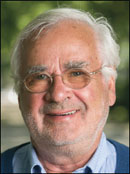Awardee Interviews | Biography: Michael Grunze
Michael Grunze

Michael Grunze, Ruprecht-Karls-University of Heidelberg, Germany, “taking surface science beyond small molecules at surfaces to complex liquid/surface interactions, including polymers, biointerphases, and biomedical applications, through development of novel experimental approaches, theoretical simulations, and inventions.”
Michael Grunze received his Ph.D. in Physical Chemistry in 1974 from the Freie Universität Berlin on the reduction of ZnO with reactive gases. Under the supervision of Wolfgang Hirschwald, he used thermogravimetric methods to derive a kinetic model for the orientation dependence of the reduction of ZnO single crystals. Subsequently, he joined the research group of G. Ertl in Munich as a post-doc and was involved in the first iron single crystal experiments to study the mechanism of nitrogen adsorption and nitrogen and ammonia dissociation in view of unsolved mechanistic questions related to the Haber Bosch Process. After a short stay with John Pritchard at Queen Mary College in London, he continued his work on catalytic surface reactions at the Fritz Haber Institute of the Max Planck Society in Berlin. The kinetic formalism he derived for nitrogen dissociation on Fe (111) surfaces provided the input for the modelling of the industrial Haber Bosch process. In 1983 he accepted a position as full professor of Physics at the University of Maine, where he developed strategies for the characterization of polymer/metal interfaces and the mechanism of adhesion in these technically important systems. During his tenure at the University of Maine, he also designed and build an x- ray photoelectron spectrometer capable to study adsorption and catalytic reactions on solid surfaces up into the mbar pressure range, a technique which is nowadays employed in several laboratories.
In 1987 M. Grunze accepted the Chair for Applied Physical Chemistry at the University of Heidelberg, where he kept his position until his retirement in 2012. His work continued to be focussed on the static and dynamic properties and applications of thin organic films, e.g. selfassembled monolayers, polymer brushes, and inorganic polymers for medical applications (polyphosphazenes). His group was the first to employ synchrotron-based methods and nonlinear optical methods (SHG and SFG) to study the molecular conformation and orientation in adsorbed organic films in air and different solvents. These experiments led to an extended interest of his group in the properties of interfacial water and the forces between objects in an aqueous environment. The experimental work was complemented by collaborative theoretical and modelling work with Hans-Jürgen Kreuzer and Alexander Pertsin, respectively. In these studies, it was shown that the conformational changes of ethylene oxide oligomers in water explain the “inertness “of the respective SAM surfaces, and that by quantitative modelling of solvation forces and their range the forces between experimentally verifiable phospholipid layers and different SAM surfaces in water can be predicted. Over the last 15 years, and ongoing, Michael Grunze´s main research activity is on environmentally benign non-fouling surfaces for marine applications, which resulted in novel strategies and experimental methods to quantify the interaction of unicellular organisms with surfaces.
Michael Grunze´s advances in surface and interface science in research areas ranging from catalysis (e.g., ammonia synthesis) to organic films (e.g., polyimide films and self-assembled monolayers) to biological applications (e.g. nonfouling surfaces and medical implants) led to several national and international awards and honorary lectures and professorships. Together with his students (he supervised 180 graduate students during his academic career), post docs and coworkers he published over 430 publications and filed over 120 patents. Michael Grunze founded and cofounded four companies during his tenure at the Fritz Haber Institute, the University of Maine, the University of Heidelberg, and after his retirement.